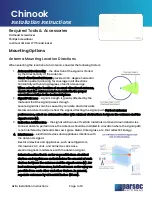
7 / 10
Offset Parabolic Antennas
Antenna earthing / lightning protection
WARNING
Risk of severe injury and/or material damage due
to lightning strike, electrostatic charge or short
circuit!
►
Make sure that grounding and lightning protec-
tion work is only performed by specially trained
electricians.
►
Never perform grounding and lightning protec-
tion work if you are not a specialist with the
appropriate knowledge.
►
An equipotential bonding conductor of 4.4 mm²
should be provided.
►
Connect the cable shields of all coaxial antenna
downlink cables to the mast using an equipoten-
tial bonding cable.
Notice
The instructions printed here are not an invitation to
nonspecialists to perform grounding and lightning
protection work on their own account.
●
Erect and ground the antenna specified in standard DIN EN
60728-11. Grounding is not required for antennas which are
installed
–
more than 2 m below the edge of the roof and
–
at the same time less than 1.5 m away from buildings.
●
For grounding, connect the mast by means of a suitable ground
conductor to the lightning protection system of the building,
using the shortest route. If no lightning protection system is
available, connect it to the building ground conductor.
●
Connections to the lightning protection system may only be
made by a specialist qualified in lightning protection system
installations.
Suitable as ground conductors is
a single solid wire with a cross-section of at least 16
mm
2
copper, at least 25 mm
2
aluminium or at least 50 mm
2
steel.
Unsuitable as ground conductors are
●
the outer conductor of the antenna cables,
●
metallic domestic installations (such as the metal pipework
of a water or heating system), since the permanence of the
electrical connection cannot be guaranteed,
●
the protective ground conductor or neutral conductor of the
mains power supply.
Routing of ground conductors
●
Do not route antenna cables and grounding conductors
through rooms used for storing easily flammable substances
(such as hay or straw) or in which an explosive atmosphere
can develop (such as gases, vapours).
●
If the parabolic antenna is used in an integrated antenna
system (e. g. a distribution system), carry out the the
grounding measures in such a way that grounding protection
is still maintained if individual units are removed or replaced.
Equipotential bonding rail
Equipotential bonding rail
Groundging
conductor
Groundging
connection
Mains connection
230 V
Equipoten-
tial bonding
cable
Equipoten-
tial bonding
cable
Fig. 12: Grounding of antenna
According to the stan-
dard, antenna grounding
is not compulsory within
the hatched area.
Fig. 13: Areas for antenna grounding




































